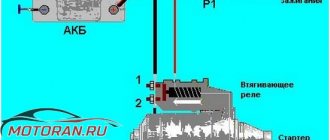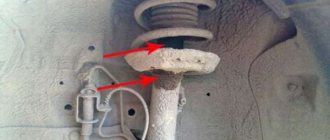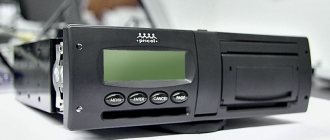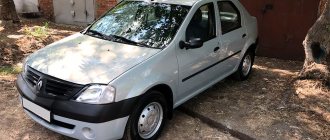This is how much rust can affect safety in an accident
Forget about performance, the biggest changes in the auto industry over the past few decades have come in the name of safety.
New cars are safer than they've ever been, and that's good news. But suppose you haven’t saved up money for a new car or you’re simply not interested in buying one, you like your old horse, which won’t ruin the furrows, it happens. Should we be wary of 8-10 year old models? It seems that the release is quite recent: 2008-2010, it seems that 80 - 90% of the various tests for survival in road accidents that modern cars undergo were in use in those days. Even the designs are generally identical compared to those offered by today's auto industry. So the old models are still as safe? Or not?
The answer may very much depend on how rusty the car body is.
Numerous automakers, especially Volvo, which is ahead of the curve, are working to make road crashes a thing of the past by introducing a variety of smart technology solutions to avoid collisions in the first place. So far it's not working out very well. Therefore, the bodies are being improved at the same time. Their strength and rigidity are increased through the use of new alloys, new reinforcements and larger deformation zones.
But all these efforts can fall apart, literally, if the car is old and rusty. After watching the visual video, you will understand what we are talking about.
The fact is that the amount and depth of rust plays a big role in a car's ability to withstand an impact.
See also: Why half of the vehicle fleet in Russia is unsafe
Researchers at Villaagarnas Riksforbund, as reported by the foreign magazine Autoweek, a non-profit Swedish organization, with the help of the insurance company, decided to test their theory using several used cars.
Nissan Pathfinder 2005–2012
Looking at the photo, the frame Pathfinder looks brutal and a little aggressive. We can say that this is a real fighter. It’s just bad luck that the body of the third generation cannot boast of strength. And this is not the only problem. Some owners of this unit note the immediate growth of rusty spots at the slightest chip in the body. The edge of the tailgate also often rusts. The same fate befalls the thresholds and the floor. The welds under the roof rails can “bloom” with red flowers. On earlier models, rust appears on the A-pillars. And the outer chrome is often peeled off in layers.
This is not a complete list of cars, of course, it will not be possible to cover everything. Problem cars also turned out to be Honda Civic, Skoda Yeti and other unsuccessful examples. So, it seems that ideal cars of famous brands cannot disappoint their owner so quickly. But the fact remains a fact. And the rusty stain still remains behind them.
If you liked the article, like and subscribe to my Yandex Zen channel!
Crash testing of old cars
The test cars were: Mazda 6 and Volkswagen Golf.
The VW model was produced from 2004 to 2008, while the Mazda 6 was in production from 2003 to 2008. So the cars aren't exactly old, but they both had a fair amount of rust.
To see how the cars survived a crash, the researchers simulated frontal and side impacts following EuroNCAP* standards.
*It is necessary to clarify that the researchers did not use the current EuroNCAP standard, but the technical documentation that was in force at the time when the test vehicles were new. New cars must comply with much stricter regulations than before.
Hyundai Creta
The sales leader on the Russian market was distinguished by its characteristic red spots. And this can be said to be a stain on the reputation of the brand. Thanks to its wide functional equipment and exceptional characteristics, the car has become desirable among consumers. The car is quite roomy, comfortable, and also versatile. But, as usually happens, such qualities may hide some kind of flaw. In this case, the mood of many owners was spoiled by rust. After just six months of purchase, the paintwork disappears somewhere. It is noteworthy that not only the most problematic areas can become stained...
The final blow for rusty Mazda and VW
Both videos show that the old, rusty cars couldn't meet the safety standards they met as soon as they rolled off the production line. No, not even like that, or rather, until the moment when they began to rust intensively. The Mazda 6, whose bodies are known for their poor rust resistance, performed very poorly, sliding down the safety ladder compared to the new model.
Video:
As shown in the video above, Mazda tests were carried out by hitting the front of the car at a speed of 64 km/h and by running over a trolley with a deformable barrier simulating a passenger car at a speed of 50 km/h.
“When the Mazda 6 was tested frontally, the vehicle was deformed such that the driver's seat ended up moving and resting against the inside of the vehicle, and the dummy hit his head on the B-pillar,” the testing organization said. Hitting your head on the central one, if anything happens, is very bad.
When the model first appeared, the new car managed to earn a rating of “weak four (26 points)” on a five-point EuroNCAP scale. The old, rusty Mazda received a downgraded rating of “weak three” (18 points) . This may not be a big deal or make a lot of sense to many people, but the main takeaway is that the researchers believe that passengers in such a vehicle have a “20 percent higher risk of dying in a real-world crash due to the presence of rust.” Almost ¼ less chance of survival! Think about such indicators and you will be horrified!
Second test subject (no less rusty, no less old)
Golf was surprisingly good. It has only lost one point in terms of its impact resistance compared to when it was new. According to the five-point EuroNCAP rating scale, the new Golf of the previous period scored a “weak five (33 points) ,” while the old one managed to get a “strong four” rating (32 points) .
Work on the car
He started with an old rusty Mercedes-Benz CLK. To fit the 30-inch wheels on it, he had to completely redo the fenders, making them huge to match the size of the wheels.
He designs the front part as an imitation of a high-end luxury car with a large radiator grille.
After the author partially puts the body in order, he begins to mold it from cardboard templates and a large amount of polyurethane foam.
After the foam dries, he begins to gradually shape it into the desired shape. This is a very long and tedious process that requires increased attention.
Then it begins to form the main lines of the body and those appearance features that will make this luxury car completely unique.
Once the artist finishes sculpting the first layer of foam, the car begins to take on a new look. It is completely different from the Mercedes he started working with.
He uses cardboard to stencil some parts of the car and bring the body lines in line with the cleaner front end.
Using long blades and various saws, he slowly cuts away pieces of foam, making beautiful lines, creating a custom design for this machine.
By adding headlights and finishing touches to the exterior, the artist has a final exterior shape that is ready for paint. It will be a fast sports car.
After working on the body, the author pays attention to the interior and interior of the car, gradually making it as unique as the body.
The final detail is painting the body in a distinctive red color, perfect for such a stylish car.
Rat Look style. What is Rat Look? How to make a car in the Rat Look style.
Rat Look Style Many people ask what the Rat Look style is
in car culture.
Rat Look (from the word “Rat” - “rat”) is an original direction of stance culture with an unusual approach to car personalization. A car in the Rat-Look style
is an outwardly battered, rusty and rotten “bucket” with a superbly restored technical filling.
In this post, I will tell you what a Rat Look is
,
how to distinguish a Rat Look style car
from a simple rusty junk, and how
to make a Rat Look style car
(are you sure you need one?).
Typically, cars in the Rat Look style appear in the hands of those people who are passionate about restoring the technical component of the car (engine, gearbox, suspension), and do not consider the appearance of the car to be something important. Gradually the body begins to rust and holes appear in it. This was the case initially, but when the Rat Look style acquired its formed features and adherents, cars in initially good condition began to undergo artificial aging. I should note that adherents of the Rat Look Style do not allow the car to rot; they maintain the good condition of all the power elements of the body, the integrity of the floor in the cabin and other important parts, allowing the attached parts to become covered with rust (or the fashionable word patina). How to make a car in the Rat Look style
Despite the fact that the liquidity of such a project drops significantly, the Rat Look style is very popular in the circles of stensers and hot rodders.
If you finally decide to create a car project in the Rat Look style
, here are a few steps/tips/recommendations on how
to make a car in the Rat Look style
: - Find a good base for the project, study all the advantages and disadvantages of the model.
Rat Look
to perfect condition .
At the very least, do the following: eliminate all oil leaks on the engine, get rid of wild burns/uneven operation of the engine, troubleshoot the gearbox and repair it, correct all the electrical wiring defects of your Rat Look
project, restore all important body components, remove outright rot of body elements .
-Think carefully about the appearance of the project, make sketches, and look for solutions from
world-class
Rat Look projects -Buy a paint thinner and a special acid that accelerates the oxidation of the metal. Remove paint in areas that you want to artificially age and patina
(oh yeah!).
Please note that the body of an old car may have undergone body repairs more than once; some parts are covered with putty, which will not rust. It is better to paint such areas in a color that matches the general style. -If desired, you can cover the parts covered with rust (or patina, oh yes!) with varnish to slow down further corrosion of the metal. -Buy all sorts of fashionable accessories, wheels with a shelf, adjust the fitment and enjoy the attention of others... -...?! PROFIT!!! How to distinguish a Rat Look car from junk cars.
Rat Look Style is one of the components of Stance culture and Custom culture.
Cars in the Rat Look style
are a kind of
“car punks”
.
And if we are talking about stance culture and custom, then these are definitely noticeable wheels (which can cost twice as much as a car), lowered suspension and other characteristic “design solutions”. So, what distinguishes a junk car from a car in the Rat Look style
: -A junk car is rotten through and through and will now crumble, and a
Rat Look Style
car is only covered with patina (how fashionable I am, I’m using fashionable words))) -A junk car won’t be able to go anywhere in a couple of kilometers, and a car in
Rat Look Style
is ready to run further than new cars from a car showroom, because its technical components are always in good working order and in excellent condition.
-The auto junk has rusty, dirty stamps, and the Rat Look Style
project has cool wheels, polished and wiped with the owner’s handkerchief.
Some people go overboard and end up with something like this. Don’t let your car get into this state: By the way, Russian cars
are great for
Rat Look projects
. Come to the AutoCult community, there are a lot of crazy people just like you who are obsessed with car customization.
Come to the AutoCult community, there are a lot of crazy people just like you who are obsessed with car customization.
Now we have a Telegram channel. Subscribe to stay up to date with the latest news!
Elimination of defects mechanically
Problem spots are eliminated mechanically in several stages. The area is thoroughly cleaned down to the metal using sandpaper. You can deal with minor problems yourself. If the area is large, you need to use a grinder or other electric tools.
Clean off rust spots carefully, gradually dealing with the problem. At the same time, be careful not to scratch the body surface.
During work, it is necessary to avoid damaging entire areas of the paintwork. The surface must be cleaned until bare metal begins to appear. After completely cleaning the car, you should treat the problem area using a special converter, which quickly copes with the smallest corrosion residues that are not always visible to the eye.
After applying the converting substance, do the following:
- wait for half an hour until the special converter stops working;
- putty the surface several times;
- sand the treated area;
- Paint the entire car one color, but you need to choose the tone carefully.
For reference!
The adjacent surface must be protected before applying paint. This can be done with newspapers and masking tape.
After applying the protection, an anti-corrosion primer is applied. The substance is used two to three times. Don't forget to dry each layer. A clear varnish is applied over the primer. This will help to reliably protect the vehicle and give it a beautiful appearance.
How effective the process of touching up rust on a car with your own hands will be is determined depending on how the instructions are followed and the work is performed.










